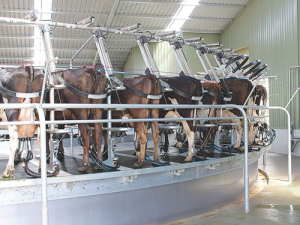The cleanliness of the milking system and the dairy is critical, and strict cleaning guidelines are needed to maintain milk quality standards.
Cleaning must be done properly so that all residues are removed and bacteria are destroyed. Bacteria can build up in the plant and contaminate milk.
The bacteria affect milk quality by breaking down the components in milk. This reduces the shelf life of milk and milk products, and produces ‘off’ flavours in cheeses and milk powders.
Bacteria can enter the plant from cows (teat skin and infected udders) and the environment (drawn into the cluster).
The milking environment is ideal for bacterial growth. Effective machine cleaning will control the presence of bacteria in the plant.
The quality of the water used is very important in achieving a successful clean.
Water that is too cool leads to redepositing of the milk residues removed, and water that is too hot denatures protein, breaks down detergents and damages seals and rubberware.
Aim for a temperature of 80-85°C as water exits the hot water storage cylinder. Hot water washes should be dumped when wash water temperature falls to below 55°C.
Hot water must contact the surface for a minimum of 4 minutes; this should be extended to 7 minutes by re-circulating during an alkali wash.
Pre-heating the plant will help achieve at least 5 minutes of contact time at the recommended temperature.
For the milking plant, 10L of hot water per cluster is recommended to achieve sufficient contact time.
For the bulk milk tank, hot water should be a minimum of 2% of the bulk milk capacity or 120L for 5700L tanks or smaller.
Air injectors and a reservoir of water at the end of the milk line can create a slug formation for cleaning the top of the milk line.
Small flushing pulsators used to induce turbulence are largely ineffective and regular brushing or use of a large flushing pulsator/air injector may be required.
Milk lines generally require turbulence created via an effective flushing pulsator to fill the line and clean the milk line or some alternate effective cleaning system.
Acid detergents remove mineral deposits. They can be used in hot or cold water but are more effective in hot water.
Acid sanitisers commonly incorporate chemicals which also kill bacteria. These are intended to stay in the plant after washing to provide extended protection. Acid sanitisers should always be added to the final wash.
Alkaline detergents remove fat and protein. If left in the plant, they can cause damage to rubberware so they must be followed with an acid wash to neutralise the alkali and leave the plant sanitised. The alkaline detergent is almost always chlorinated, or chlorine added.
Cleaning routines
As a minimum the following steps are needed:
- Cold water rinse after every milking
- An acid wash after every milking
- An alkali wash at least twice weekly
- An acid rinse after every alkali wash.
• Article: DairyNZ


















